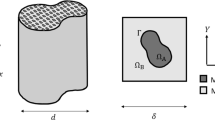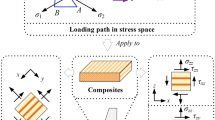Summary
The modelling of the mechanical properties of a macrostructure, representative of the total structure, is demonstrated by the example of the unidirectional SiC fibre-reinforced SiC composite. The macrostructure is modelled from a suitable number of substructures, based on the properties of the individual phases and their interactions. The numerical access in the model is accomplished by means of the Finite Element Method (FEM). In numerical simulations, the statistically verified events of damage in the macrostructure are described. Finally the effect of important parameters like the fibre number, the fibre-matrix friction and the fibre Weibull parameter on the nonlinear behaviour of the macrostructure will be examined.
Similar content being viewed by others
References
Phillips, D. C.: Fibre reinforced ceramics. In: Survey of the technological requirements for high temperature materials R&D — Section 3: Ceramics composites for high temperature engineering applications (Davidge, R. W., ed.), pp. 48–73. Luxembourg: Commission of The European Communities 1985.
Ziegler, G.: Hochfeste faserverstärkte Verbundwerkstoffe mit keramischer Matrix. Symposiumsband BMFT-Materialforschung 1988, Hamm 1988.
Ziegler, G.: Keramik — eine Werkstoffgruppe mit Zukunft. Metall41, 682–695 (1987).
Ziegler, G.: Entwicklungstendenzen der Hochleistungskeramik. Ceramic Forum International — Bericht der DKG 68/3, 72–79 (1991).
Rouby, D.: Verbundwerkstoffe aus keramischen Fasern und keramischen Matrizen. Ceramic Forum International — Bericht der DKG 66/5-6, 208–216 (1989).
Hoffman, O.: The brittle strength of orthotropic materials. J. Comp. Mat.1, 200–206 (1967).
Sutcu, M.: Weibull statistics applied to fiber failure in ceramic composites and work of fracture. Acta Metall.37, 651–661 (1989).
Ismar, H., Reinert, U.: Modelling of the micromechanical behaviour of unidirectional fibre-reinforced ceramics by the example of SiC/SiC. Arch. Appl. Mech.66, 34–44 (1995).
De Borst, R., Nauta, P.: Non-orthogonal cracks in a smeared finite element model. Eng. Comput.2, 35–46 (1985).
Li, F. Z., Shih, C. F., Needleman, A.: A comparison of methods for calculating energy release rates. Engng. Fract. Mech.21, 405–421 (1985).
Stinton, D. P., Caputo, A. J., Lowden, A. L.: Synthesis of fiber-reinforced SiC composites by chemical vapor infiltration. Ceramic Bull.65, 347–350 (1986).
Köberle, H., Mühlratzer, A., Peetz, K.: CVI — produced ceramic composites. Proceedings of The 11th International Europan SAMPE Conference 1990, Basel 1990.
Kaliszky, S.: Plastizitätslehre — Theorie und technische Anwendungen. Düsseldorf: VDI-Verlag 1984.
Prewo, K. M., Brennan, J. J., Layden, G. K.: Fiber reinforced glasses and glass-ceramics for high performance applications. Ceramic Bull.65, 305–313 (1986).
Chen, T., Dvorak, G. J., Benveniste, Y.: Stress fields in composites reinforced by coated cylindrically orthotropic fibers. Mech. Mat.9, 17–32 (1990).
Weihs, T. P., Dick, C. M., Nix, W. D.: The frictional resistance to sliding of a SiC fiber in a brittle matrix. Materials Research Society Symposium Proceedings120, 247–252 (1988).
Marshall, D. B., Oliver, W. C.: Measurement of interfacial mechanical properties in fiber-reinforced ceramic composites. J. Am. Ceramic Soc.70, 542–548 (1987).
Shafry, N., Brandon, D. G., Terasaki, M.: Interfacial friction and debond strength of aligned ceramic matrix composites. In: Euro-Ceramics I — Vol. 3: Engineering ceramics (de With, G., Terpstra, R. A., Metselaar, R. eds.). Elsevier 1989.
Aboudi, J.: Micromechanical analysis of fibrous composites with Coulomb frictional slippage between the phases. Mech. Mat.8, 103–115 (1989).
Klaffke, D.: Reibung von Paarungen “Keramik/Keramik” und “Keramik/Metall”. VDI-Berichte Nr. 600.3, 105–120 (1989).
Jahanmir, S., Deckman, D., Ives, L., Feldman, A., Farabaugh, E.: Tribological characteristics of synthesized diamond films on silicon carbide. Wear Mat.1, 375–379 (1989).
Köberle, H., Mühlratzer, A., Peetz, K.: Properties of ceramic matrix composites. In: Euro-Ceramics II — Vol. 2: Structural ceramics and composites (Ziegler, G., Hausner, H., eds.), pp. 1667–1671. Köln: DKG 1993.
Wantzen, B.: SiCarbid- und Siliziumnitrid-Fasern für den Hochtemperaturbereich. Magazin Neue Werkstoffe3, 24–25 (1990).
Author information
Authors and Affiliations
Additional information
Dedicated to Prof. Dr.-Ing. Dr.-Ing. E. h. mult. Oskar Mahrenholtz on the occasion of his 65th birthday
Rights and permissions
About this article
Cite this article
Ismar, H., Reinert, U. Modelling and simulation of the macromechanical nonlinear behaviour of fibre-reinforced ceramics on the basis of a micromechanical-statistical material description. Acta Mechanica 120, 47–60 (1997). https://doi.org/10.1007/BF01174315
Received:
Revised:
Issue Date:
DOI: https://doi.org/10.1007/BF01174315




